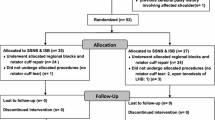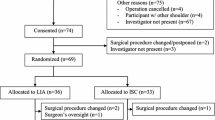Abstract
Purpose
Ultrasound (US)-guided continuous interscalene brachial plexus block (CBPB) is known to provide effective pain relief for arthroscopic rotator cuff repair. This study was conducted to compare analgesic efficacy and forearm muscle tone of the basal infusion rate and bolus dose of 0.2 % ropivacaine for US-guided CBPB with intravenous patient-controlled analgesia (IV-PCA).
Methods
In a prospective trial, 99 patients scheduled to undergo arthroscopic rotator cuff repair were divided into three groups. In groups A and B, an US-guided 17-gauge Tuohy needle was inserted into the interscalene brachial plexus. A loading dose of 10 ml 0.2 % ropivacaine was administered via the needle. A 19-gauge perineural catheter was then inserted through the needle and advanced to a depth of 1.5 cm beyond the needle tip between the C5 and C6 nerve trunks. After surgery, groups A and B received a continuous infusion of 0.2 % ropivacaine at 4 or 0 ml/h, a bolus of 0 or 4 ml, and a lockout time of 60 min through the catheter, respectively. Group C received IV-PCA. Pain scores and the forearm muscle tone of patients were compared using a numeric rating scale (NRS), rates of patients taking supplementary opioid analgesics, and manual muscle test (MMT) scoring.
Results
The NRS scores and rate of patients taking supplementary opioid analgesics in groups A and B were lower than those in group C after surgery. Groups A and B showed similar clinical efficacy. There were no significant differences in MMT scoring among the three groups.
Conclusions
The bolus dose of 0.2 % ropivacaine using US-guided CBPB would provide equivalent analgesic efficacy comparable with the basal infusion and motor weakness comparable with IV-PCA after arthroscopic rotator cuff repair.


Similar content being viewed by others
References
Rawal N, Hylander J, Nydahl PA, Olofsson I, Gupta A. Survey of postoperative analgesia following ambulatory surgery. Acta Anaesthesiol Scand. 1997;41:1017–22.
Oh JH, Rhee KY, Kim SH, Lee PB, Lee JW, Lee SJ. Comparison of analgesic efficacy between single interscalene block combined with a continuous intra-bursal infusion of ropivacaine and continuous interscalene block after arthroscopic rotator cuff repair. Clin Orthop Surg. 2009;1:48–53.
Borgeat A, Schappi B, Biasca N, Gerber C. Patient-controlled analgesia after major shoulder surgery: patient-controlled interscalene analgesia versus patient-controlled analgesia. Anesthesiology. 1997;87:1343–7.
Fredrickson MJ, Krishnan S, Chen CY. Postoperative analgesia for shoulder surgery: a critical appraisal and review of current techniques. Anaesthesia. 2010;65:608–24.
Ilfeld BM, Morey TE, Wright TW, Chidgey LK, Enneking FK. Interscalene perineural ropivacaine infusion: a comparison of two dosing regimens for postoperative analgesia. Reg Anesth Pain Med. 2004;29:9–16.
Marhofer P, Chan VW. Ultrasound-guided regional anesthesia: current concepts and future trends. Anesth Analg. 2007;104:1265–9.
Eichenberger U, Stockli S, Marhofer P, Huber G, Willimann P, Kettner SC, Pleiner J, Curatolo M, Kapral S. Minimal local anesthetic volume for peripheral nerve block: a new ultrasound-guided, nerve dimension-based method. Reg Anesth Pain Med. 2009;34:242–6.
Antonakakis JG, Sites BD, Shiffrin J. Ultrasound-guided posterior approach for the placement of a continuous interscalene catheter. Reg Anesth Pain Med. 2009;34:64–8.
Clarkson HM. Musculoskeletal assessment: joint range of motion and manual muscle strength. Philadelphia: Lippincott; 2000.
Delaunay L, Souron V, Lafosse L, Marret E, Toussaint B. Analgesia after arthroscopic rotator cuff repair: subacromial versus interscalene continuous infusion of ropivacaine. Reg Anesth Pain Med. 2005;30:117–22.
Tuominen M, Pitkanen M, Rosenberg PH. Postoperative pain relief and bupivacaine plasma levels during continuous interscalene brachial plexus block. Acta Anaesthesiol Scand. 1987;31:276–8.
Singelyn FJ, Seguy S, Gouverneur JM. Interscalene brachial plexus analgesia after open shoulder surgery: continuous versus patient-controlled infusion. Anesth Analg. 1999;89:1216–20.
Baciarello M, Danelli G, Fanelli G. Real-time ultrasound visualization of intravascular injection of local anesthetic during a peripheral nerve block. Reg Anesth Pain Med. 2009;34:278–9.
Denny NM, Harrop-Griffiths W. Location, location, location! Ultrasound imaging in regional anaesthesia. Br J Anaesth. 2005;94:1–3.
Borgeat A, Dullenkopf A, Ekatodramis G, Nagy L. Evaluation of the lateral modified approach for continuous interscalene block after shoulder surgery. Anesthesiology. 2003;99:436–42.
Acknowledgments
This work was supported by a 2-year Research Grant of Pusan National University.
Author information
Authors and Affiliations
Corresponding author
About this article
Cite this article
Shin, SW., Byeon, GJ., Yoon, JU. et al. Effective analgesia with ultrasound-guided interscalene brachial plexus block for postoperative pain control after arthroscopic rotator cuff repair. J Anesth 28, 64–69 (2014). https://doi.org/10.1007/s00540-013-1681-x
Received:
Accepted:
Published:
Issue Date:
DOI: https://doi.org/10.1007/s00540-013-1681-x




